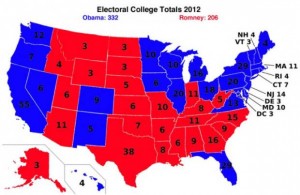Now that a Virginia state senator has dropped plans to re-work his state’s method of allocating votes in the Electoral College, let’s consider some other proposals for “improving” this venerable, if somewhat creaky, institution.
One, called the National Popular Vote Interstate Compact, comes out of California, home to many nutty ideas, though this particular one has been endorsed by some conservatives as well, including Utah’s always interesting state senator Howard Stephenson. In brief, the Compact would require the Electors of each compacting state to cast their ballot in the Electoral College for the winner of the national popular vote majority.
As of this writing, the Compact has been adopted by California and seven other states (Washington, Illinois, Vermont, Massachusetts, New Jersey, Maryland, Delaware), plus the District of Columbia. The number of EC votes affected amounts to 132 of the 270 that would be needed for an Electoral College majority. Under the terms of the Compact, it does not become effective until states controlling 270 EC votes have joined. Therefore, if states with another 140 EC votes were to join the Compact, it would go into effect, with the result of the practical elimination of the EC, without the trouble of a Constitutional Amendment.
There are a number of practical problems with this scheme, and not a few perverse incentives. On the practical side, there are about 200,000 voting districts in the United States. Recounting any given precinct might change the tally by up to five votes. Normally that makes no practical difference, since a change of five votes in even every precinct in a state is unlikely to change the EC total, but under the Compact, in any election where the margin is under a million votes, there would be a strong incentive to recount every precinct in the country.
On the incentive side, a state could increase its electoral heft by gaming the eligibility rules. The 26th Amendment to the Constitution sets a maximum voting age of 18, but nothing prevents a state from setting a lower limit. The Compact would encourage states to lower the voting age to 16, 14, or even 12, in an effort to increase the relative weight of their electorate with respect to the rest of the nation. Talk about a race to the bottom! (That same incentive would prevail in any direct election of the president scheme.)
Lax state registration standards, including registration of illegal aliens would also become more attractive, as would the usual techniques of voting the graveyard and voting in multiple districts. When registered voters change voting districts, there would be less incentive to purge them from the old district, and more incentive to encourage them to cast multiple ballots.
These practical considerations do not exhaust the problems with the Compact. Consider the actual impact of this scheme as it might work out. Let’s suppose that Mitt Romney had narrowly won the popular vote against Obama last November (though as noted above, we might not know that for weeks or months after the election). Under this “reform,” the 55 electoral votes from California would have been cast for Romney, though Obama won the state by more than three million votes. Granted, under the present EC, Republican efforts in California are desultory at best, and the Compact would have provided more incentive for Romney to campaign there, so let’s assume he might have cut the margin to a million votes. Can you imagine the outcry from Democratic voters in San Francisco whose EC votes went for the Republican? Talk about your Faithless Elector! It’s hard to imagine anything more destabilizing—or de-legitimizing.
In addition to these practical problems, there are still others. To begin with, when would we know that the Compact had “worked”? In addition to the recount problem mentioned above, and the problem of counting absentee and provisional ballots (offering other opportunities to fiddle with national totals), the Electors are chose by the voters in November. In December they convene at the state capital/capitol and cast their ballots, which are sealed and sent to the President of the Senate (the Vice President). In January he opens the ballots (in the presence of the Congress assembled) and they are counted. Only then would we know if the Electors have followed the Compact, as required by state law.
And what if they hadn’t? What is the penalty? Are they going to be taken out and shot for following the Constitution rather than state law? It’s hard to imagine a winning legal strategy a state could pursue. In the meantime, uncertainty reigns.
There are legitimate criticisms to be made of the Electoral College, though there is something to be said for it as well. I will have more to say on the latter point in the future, but for the moment, let me just note that if we don’t like the system the Framers gave us, they provided a mechanism for debating and adopting changes. That method involves a national debate, and the agreement of three-fourths of the states. It does not allow for the imposition of changes by as few as 11 states entering into an Interstate Compact.
– – – – – – – – – –
Gordon S. Jones is a senior fellow at Frontiers of Freedom. Jones is also an adjunct professor at Utah Valley University and Salt Lake Community College. Jones has extensive experience in Congress, in public policy, and elective politics.
